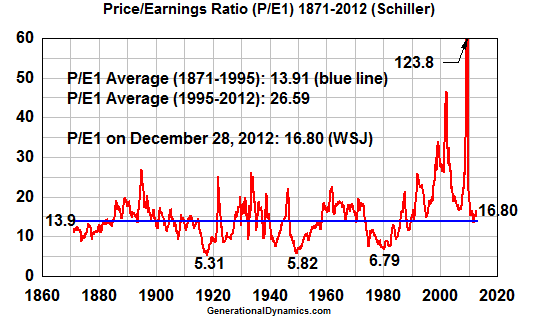Younger Brother wrote:
> With interest rates at near zero, I don't see how stocks could
> fall that far. Wouldn't interest rates have to rise first?
You're thinking of how economics worked between 1945 and 2000.
Today's economics follows the rules of the 1930s, which were
different. Today's deflationary spiral is caused by the
collapse/deleveraging of the real estate and credit bubbles, and
that's still going on. Nothing like that was going on prior to 2000.
The Fed and the ECB today are pouring trillions of "printed" money
into the banking systems, something that would have caused explosive
hyperinflation prior to 2000, but which is having little or no effect
today. So the rules are different.
jwfid wrote:
> I have to disagree with any chart or data that uses P/E anymore
> ever since 2009, when the FASB GAAP requirements were suspended
> and companies, especially financial companies, could mark their
> assets to pretty much pure fantasy. Also, who knows how many
> companies out there cooking their books just like Enron and
> Worldcom.
> I wouldn't be surprised if the true P/E is right now higher than
> the peak of 120.
It's not clear to me why fantasy valuations of existing assets (which
I've been writing about for years) would affect earnings, Joe.
Perhaps you could explain that connection.
Reality Check wrote:
> Clearly something weird went on with that chart during the peaks
> between the mid 1990s and today, but there could be a number of
> explanations that do not include makings sweeping conclusions.
> When large corporations are audited something strange happens when
> either profits, or losses are very close to non-existent.
What happened that was weird was the biggest real estate fraud in the
world's history, with tens of trillions of dollars in fraudulent CDOs
and hundreds of trillions of dollars in interest rate swaps and credit
default swaps. Given that the entire U.S. GDP is only $14 trillion,
we have a situation where the tail of the dog is many times bigger
than the dog.
You're right that the very high (123.8) values were caused by
near-zero or negative earnings, but if you're really bothered by the
specific figures in 2007-2010, then ignore them. That still doesn't
change the fact that P/E1 has been historical high continuously since
1995, and it's that fact that leads to the "sweeping conclusions."
The high peaks are part of the picture, but even if the peak had been
30, it wouldn't change the conclusions.
Reality Check wrote:
> Little Brother makes another great point, during recessions like
> the one in the early 1980s interest rates sky rocketed sucking
> money out of the stock market in to various triple AAA rated bonds
> and other investments that were favorable during high interest
> rate periods. That does not describe the recension and extremely
> weak expansion period after 2007.
Once again, today's economy can only be compared to the 1930s, not to
the 1980s. In today's economy, we've gone through a period where AAA
rated bonds turned out to be fraudulent, and few people trust the AAA
rating any more.
I remember talking to a corporate CFO after August 2007, telling him
that his investments may have a problem. He told me that there was no
problem, since he only invested in AAA rated securities. Despite my
warning, he was completely blindsided by what happened. No one would
make that mistake today.
Reality Check wrote:
> That is that companies stock price can be justified on both asset
> value and/or and the perceived rise in future earnings.
> The rise in future earnings expectation after the deep V downside
> recession after 2007 could explain part of it.
This is where you get into a lot of fraud. When you talk about
"future earnings," you're talking about data published in press
releases by people paid to lie, if necessary, to keep stock prices
high.
When you're talking about the P/E1 computation, you're talking about
very different kind of data. P is the current price of the stock, and
that can't be fudged. E1 is the earnings for the previous year,
produced by the company's accountants, audited by the company's
auditors, and checked by the IRS. Unlike "future earnings," when a
company lies about E1, then they're committing a crime with
significant civil and legal penalties.
That's why P/E1 is, in my opinion, the best measure available for how
a stock is doing, or how the entire stock market is doing. If the S&P
500 P/E1 index has been historically high for 17 years, then you know
that the stock market is dysfunctional, and headed for a major crash.
John

